The first mistake most anglers make when fishing through the winter is they pick a venue that’s unlikely to give them the results they crave. In other words, unless you are targeting a particular fish or venue, then choose somewhere that will at least give you the best chance of a fish or two. There are plenty of venues that will offer the chance of some winter action, Thorpe Lea near Egham in Surrey, Cemex Angling’s Southlake and Sandhurst lakes in Yateley are just a small selection of fisheries that will keep those rods bending even in the coldest of conditions.
The second biggest mistake anglers make when starting a winter campaign, is not having the right kit for the cold and wet conditions. Let’s look at some of the kit that you will definitely need, and will go someway to making those winter sessions more bearable!
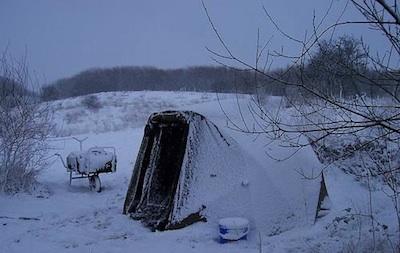 A good quality twin skinned shelter: There are a multitude of various shelters, bivvies and umbrella systems that will provide perfectly adequate protection from all but the most severe of conditions that the British weather can throw at us. The second or ‘twin’ skin traps the warm air between the layers and prevents condensation build up on the inner layer of the shelter. There is nothing worse than being woken up by drips of freezing moisture landing on your face! To match this, a good heavy duty groundsheet will prevent the cold and damp from rising up from below, and a good 5 season sleeping bag will be sufficient to keep you warm and toasty through the long nights. If desired, you can add a thermal sleeping bag cover to further add to the warmth.
A good quality twin skinned shelter: There are a multitude of various shelters, bivvies and umbrella systems that will provide perfectly adequate protection from all but the most severe of conditions that the British weather can throw at us. The second or ‘twin’ skin traps the warm air between the layers and prevents condensation build up on the inner layer of the shelter. There is nothing worse than being woken up by drips of freezing moisture landing on your face! To match this, a good heavy duty groundsheet will prevent the cold and damp from rising up from below, and a good 5 season sleeping bag will be sufficient to keep you warm and toasty through the long nights. If desired, you can add a thermal sleeping bag cover to further add to the warmth.
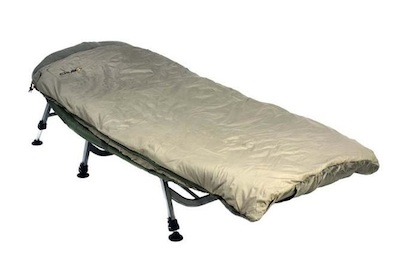 Clothing is a another area that anglers sometimes underestimate the importance of. Again there are lots of good quality reasonably priced winter clothing to choose from, but remember the layering principal; the more layers you have on the warmer you will be, as the warm air is trapped between each layer. This also makes it easy to control your temperature by removing one layer at a time or adding an extra one should you become too hot or cold. A decent woolly hat is vital as the majority of your body heat is lost through your head.
Clothing is a another area that anglers sometimes underestimate the importance of. Again there are lots of good quality reasonably priced winter clothing to choose from, but remember the layering principal; the more layers you have on the warmer you will be, as the warm air is trapped between each layer. This also makes it easy to control your temperature by removing one layer at a time or adding an extra one should you become too hot or cold. A decent woolly hat is vital as the majority of your body heat is lost through your head.
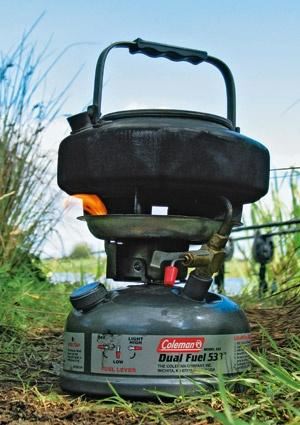 Plenty of hot food and drinks are not only essential in the cold but can be a great moral boost too. Plenty of hot drinks and a piping hot meal can do wonders when the fishing is slow.
Plenty of hot food and drinks are not only essential in the cold but can be a great moral boost too. Plenty of hot drinks and a piping hot meal can do wonders when the fishing is slow.
Moving on to the actual fishing side of things, you don’t need to make drastic changes to your rigs or bait, but subtle adjust
ments and tweaks can be the difference between blanking and catching! Dropping down a hook size or switching to fluorocarbon hook links can help snare those finicky feeding carp, and shrinking the size of the baits you use can also. Leave those 18mm boilies at home and try a bag of 10mm baits instead. The same with pop ups; a tiny 10mm pop up with a size 10 wide gape hook is one of my favourite winter tactics and has accounted for numerous cold water carp. Only last week in those heavy frosts I snared a 34lb mirror on a 10mm bottom bait and a size 10 hook, proof indeed that size isn’t everything!
Often with the colder weather there comes an increase in water clarify. This leads the angler to having to make a few changes that can give you an edge over finicky carp! A fluorocarbon leader instead of leadcore will greatly increase the concealment of your end tackle. With fluorocarbon having the same light refraction as water, it appears to disappear when submerged and can bag an extra bite or two when the going gets tough.
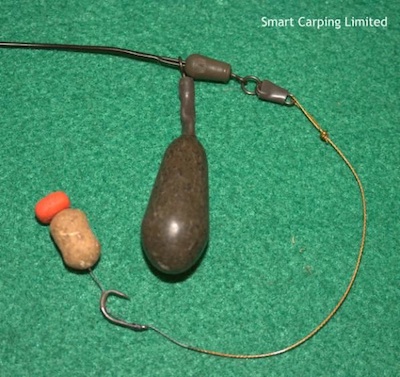 Another good edge is to not put all your eggs in the same basket as it were. Most of us will be fishing with 2 or maybe 3 rods. If so, then try different rigs and baits on each rod to maximise your chances of a bite. On one rod perhaps try a single bright pop up, and on another rod try a small 10mm bottom bait and a bag of pellets; the 3rd rod could perhaps be a highly over flavoured bait such as a pineapple or tutti fruitti pop up glugged in a sweet ethyl alcohol flavour. These potent bright baits can often provoke a response from a passing carp!
Another good edge is to not put all your eggs in the same basket as it were. Most of us will be fishing with 2 or maybe 3 rods. If so, then try different rigs and baits on each rod to maximise your chances of a bite. On one rod perhaps try a single bright pop up, and on another rod try a small 10mm bottom bait and a bag of pellets; the 3rd rod could perhaps be a highly over flavoured bait such as a pineapple or tutti fruitti pop up glugged in a sweet ethyl alcohol flavour. These potent bright baits can often provoke a response from a passing carp!
If you are a pellet user, then the high oil trout pellets or similar are not the way to go, try switching to a low oil carp pellet or betaine pellet. The low oil levels will be much more appealing to the carp than an oil soaked pellet, the cold water can cause the oil to congeal and if you imagine eating a piece of lard… well, its not very appealing is it!
Bait application is just as important in the winter as it is in the summer months. Little and often feeding will usually be more accepted by the fish, rather than filling the lake in with bait from the outset; remember you cant take it out once you have put it in!
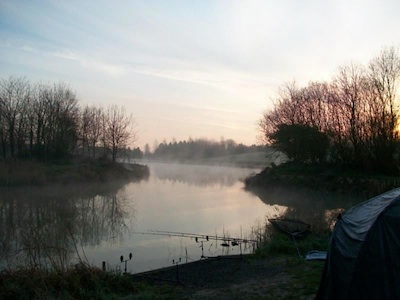 On the subject of bait, if you are using boilies then avoid baits containing high levels of oil, and baits that are fishmeal dominated. A bait with a high birdfood or milk protein base will be much more appealing and more readily digested by the carp. If in doubt, seek advice from your local tackle shop. Superb winter baits like Richworth’s tutti fruitti, Mainline Cell and Dynamite baits tiger nut boilies are all proven winners, but find one that works for you. A good bet is to keep an eye on the catch reports from the lake you fish; most lakes have a favourite winter bait.
On the subject of bait, if you are using boilies then avoid baits containing high levels of oil, and baits that are fishmeal dominated. A bait with a high birdfood or milk protein base will be much more appealing and more readily digested by the carp. If in doubt, seek advice from your local tackle shop. Superb winter baits like Richworth’s tutti fruitti, Mainline Cell and Dynamite baits tiger nut boilies are all proven winners, but find one that works for you. A good bet is to keep an eye on the catch reports from the lake you fish; most lakes have a favourite winter bait.
Location of fish is always crucial but in winter it is vital! It’s fair to say that shallower lakes fish better in the winter as the water can warm quicker, but don’t neglect the deeper areas of the lake, as the fish will often frequent these areas when angling pressure is high. Fish will actively seek the warm layers of the water, and this may be at mid depth, so, especially on bright sunny days, a zig rig fished at various depths can be a devastatingly effective tactic, a simple 8lb double strength hook link fished at 3⁄4 depth with a small size 12 hook and small bright hook bait can often out-fish other tactics. Change the depth of the zig rigs regularly to find at what depth the fish are.
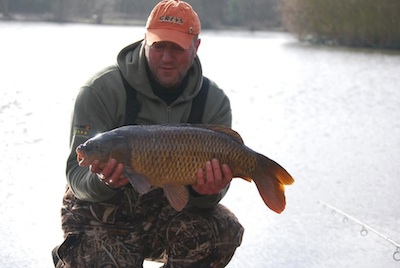 Bite times! On the majority of lakes, feeding patterns will emerge. Periods during the day when the fish want to feed. These may last one hour or five hours depending on the lake, but make sure you plan your sessions around these all important bite times! Remember, 3 hours in the right place, is better than 24 hours in the wrong place!
Bite times! On the majority of lakes, feeding patterns will emerge. Periods during the day when the fish want to feed. These may last one hour or five hours depending on the lake, but make sure you plan your sessions around these all important bite times! Remember, 3 hours in the right place, is better than 24 hours in the wrong place!
When the wind blows, the common idea is to fish on the back of the wind in the water, this basically means fishing with the wind blowing from behind you, rather than into your face. Not only is this much more comfortable to fish in, but the fish will often shelter in the calmer water on the back of the wind, rather than following a prevailing wind down the lake like they can do in the warmer months. Personally I think this only applies to large expanses of open water, so if you are fishing a 2 acre pool, then I doubt it will make much difference but on a 35 acre windswept gravel pit, I would certainly be looking for the calmer water.
This brings me onto observation. Quite often anglers are prisoners in their own bivvies, sheltering from the cold or enjoying a lay-in come first light. But this is when the angler needs to be sat outside, watching the water, scanning for any signs of feeding fish! Carp do give their location away in the winter, not as frequently as they will do in the warmer conditions but if you look hard enough in the right places, they will give clues as to their whereabouts. Dying weed beds are a great place to look as they hold both food and warmth, the shelter of islands on the leeward side is also a good place to start, patches of fizzing bubbles, the water dis-coloration as carp stir up the bottom, and obviously any showing fish will give you clues as to where to place your hook baits.
When the cold weather takes hold, don’t neglect the rivers. They are very often the only waters which won’t freeze and the fish are constantly on the move, especially in faster flowing stretches. This causes the carp to use more energy and of course they need to feed to replace it! Any carpy looking features are a good starting point, bridges, moored boats, islands, etc are all spots that may hold fish. Give it a go, you may be pleasantly surprised! If the idea of fishing a river is new to you, then give me a ring, and book a days fishing with me.
My top ten winter tips!
1. Be prepared! Make sure you have the kit to keep you warm and comfortable.
2. Scale down your tackle! Drop a hook size, or use a lighter breaking strain hook link.
3. Bait correctly! Don’t fill the lake with bait; use small baits and mouthfuls of free offerings to begin with.
4. Choose a venue to suit your angling! Well stocked day ticket waters will keep you catching all year!
5. Keep em peeled! Observation is key, be prepared to move onto showing fish.
6. Work out the bite times! On most lakes a feeding spell may only last a few hours, make sure you are on the lake for these times.
7. Don’t neglect the naturals! Maggots are a fantastic winter bait and can fished relatively easily, with a simple mag aligner rig and mesh bag of freebies.
8. Do your homework, once you have chosen a venue, research it as much as possible, the internet angling forums are a great place to gain snippets of information.
9. Plenty of warm food and hot drinks!
10. Enjoy it! The fish are at their top weights and looking as good as they ever will, don’t let a blank session put you off, perseverance is the key! I hope this has given you a bit of encouragement to get out on the banks this winter.
Tight lines.
If you are still a bit unsure about giving winter carping a go and need a bit of help, get in touch with Ian and arrange a day with him to help show you the way! You will not regret it!













